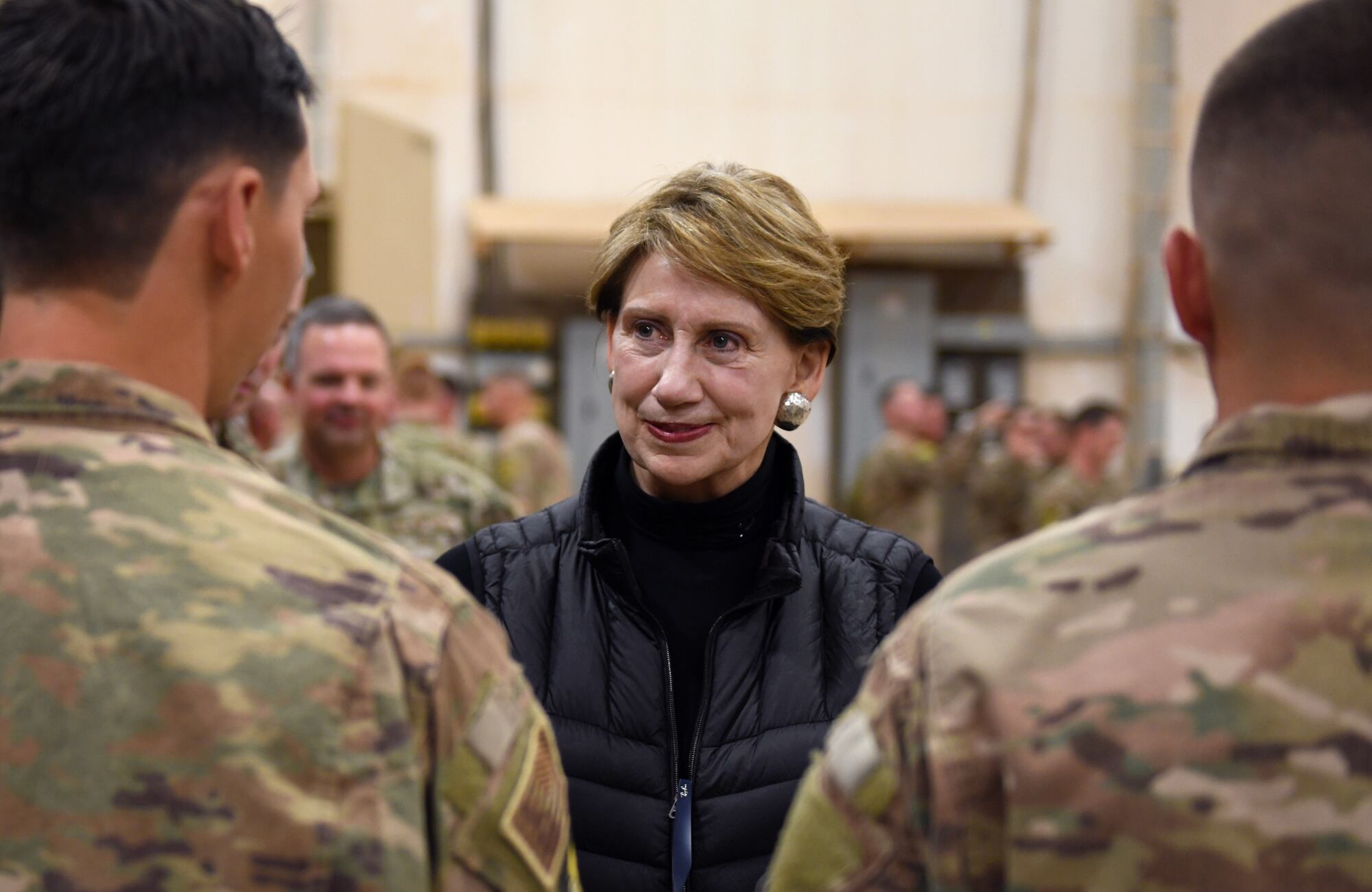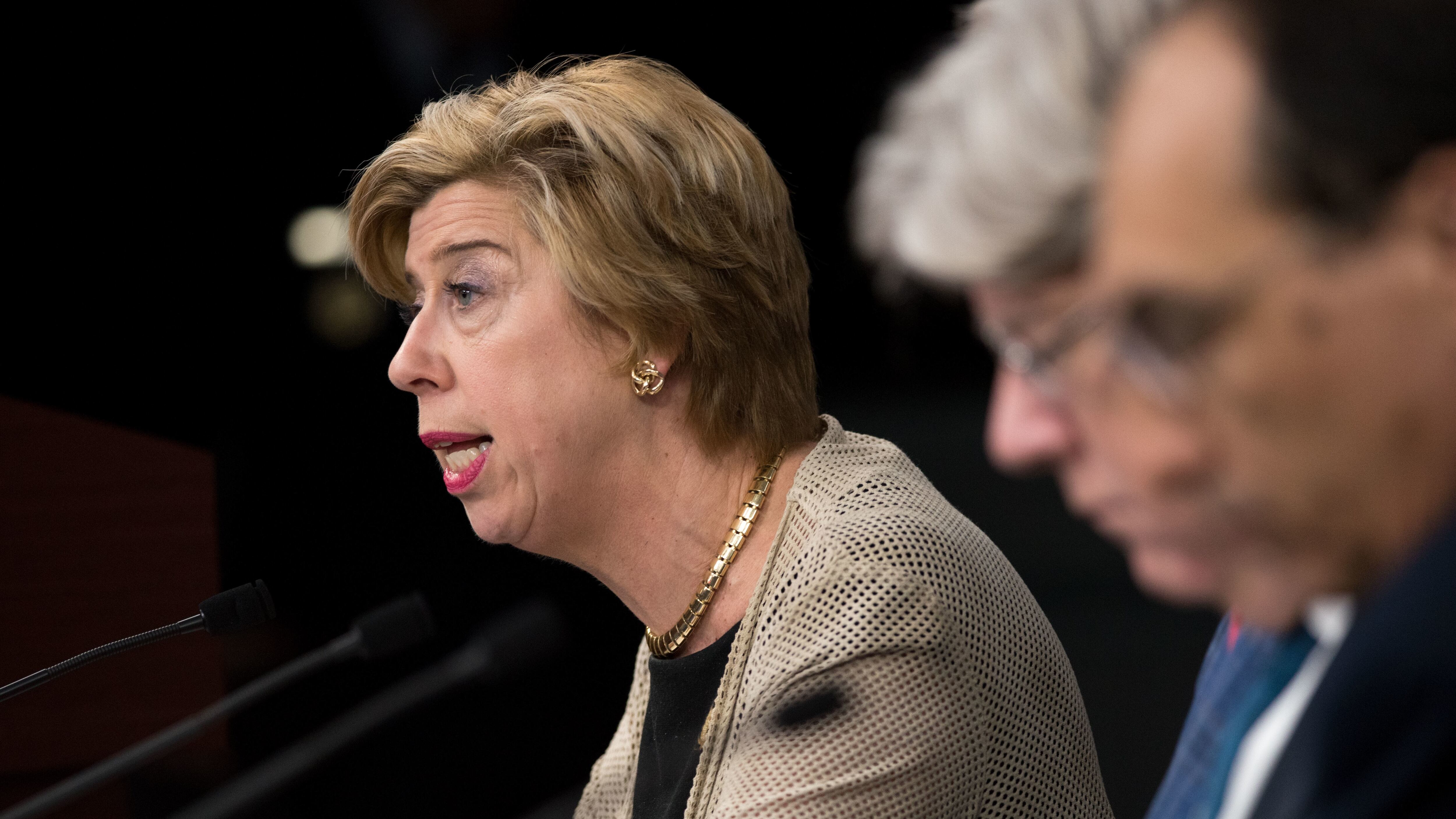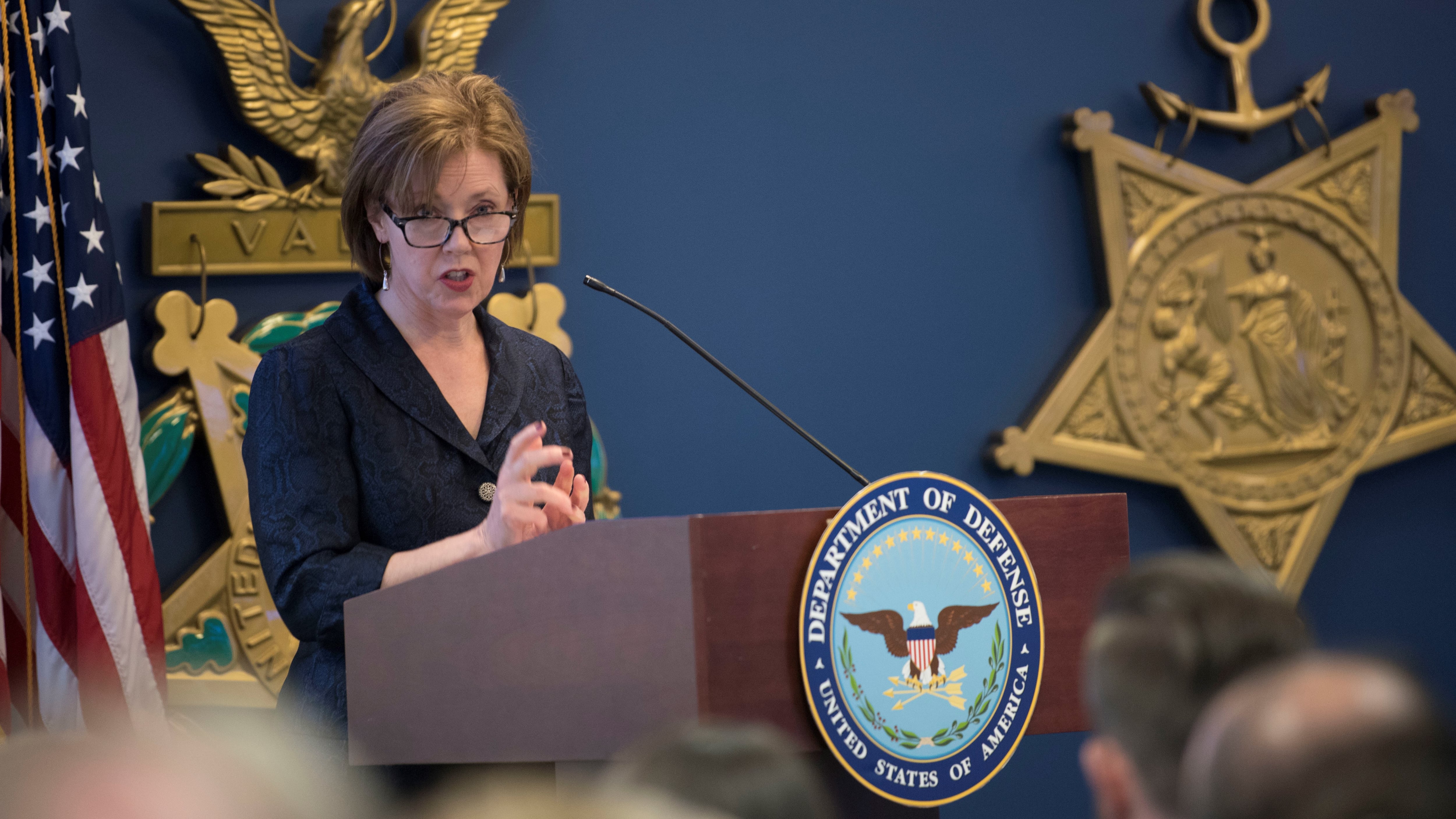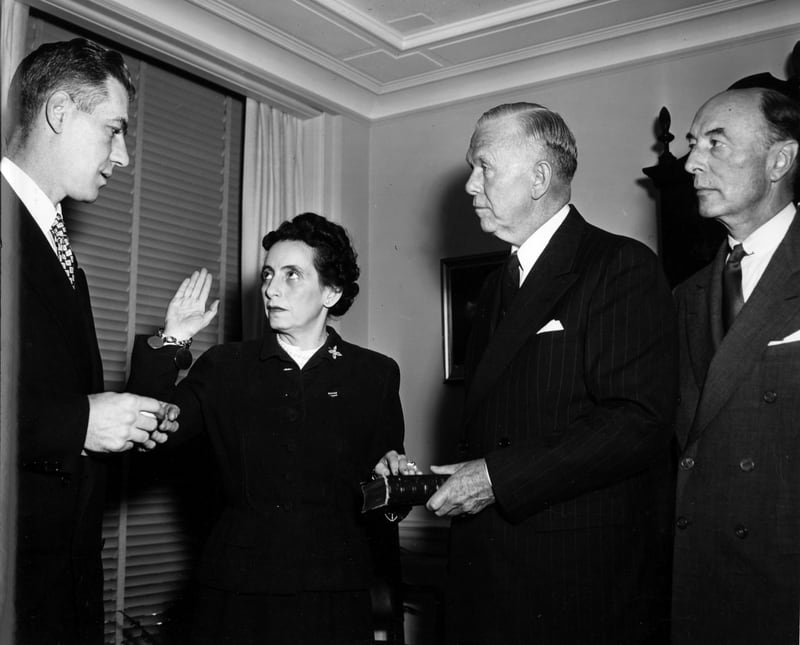WASHINGTON — When Elaine McCusker, Kathryn Wheelbarger and Lisa Porter announced their resignations from the Department of Defense within a week of each other, it represented more than just the opening up of more empty seats in the Pentagon.
McCusker, the acting comptroller, and Wheelbarger, the acting assistant secretary for international security affairs, were two of the highest-powered women in a building where gender balance in top roles has historically been a foreign concept. And their exits, so close together and under similar circumstances, led to talk in national security circles about the number of women left in top jobs at the department.
That issue only jumped in visibility on June 23, when Porter, the No. 2 at the department’s research and engineering office, submitted a joint resignation with her boss, Mike Griffin.
There are 60 spots in the Pentagon that require Senate confirmation, according to the DoD. And once the departures of McCusker, Wheelbarger and Porter are complete by July 10, only three of those spots will be filled by women who were appointed by the Trump administration.
Overall, there are 43 Senate-confirmed appointees currently working in the department. Of the announced nominees awaiting confirmation, seven are men and one is a woman.
In addition, of the nine spots with a non-confirmed official acting in the full role, the sole woman is Virginia Penrod, the acting assistant secretary for manpower and reserve affairs. (The Pentagon has yet to say who will become the acting officials for McCusker, Wheelbarger, Griffin or Porter once they officially depart.)
The women currently in office are Lisa Hershman, the department’s chief management officer; Ellen Lord, undersecretary for acquisition and sustainment; and Air Force Secretary Barbara Barrett. In addition, there is Susan Gibson, the National Reconnaissance Office’s inspector general; however, Gibson was appointed and confirmed at the tail end of the Obama administration. And finally, Michele Pearce, the nominee to be general counsel of the Army, is awaiting a hearing in front of the Senate Armed Services Committee.
In addition to the women currently serving, there have been four others who were appointed and have since resigned during the administration: Heather Wilson, the Air Force secretary and the first confirmed appointee in the building after then-Defense Secretary Jim Mattis; Kari Bingen, principle deputy undersecretary for intelligence; Veronica Daigle, assistant secretary of defense for readiness; and Phyllis Bayer, assistant secretary of the Navy for energy, installations and environment.
There have been other notable women appointed to national security roles in the Trump administration — such as Lisa Gordon-Hagerty, who oversees the National Nuclear Security Agency, and Andrea Thompson, who spent a little over a year as the undersecretary of state for arms control and international security affairs.
But all told, through three and a half years of the Trump administration, there have been nine women confirmed to Pentagon jobs, with a tenth pending.

Certainly, the women in place now hold high-profile jobs. Hershman is technically the No. 3 official in the department, although she does not have a hand in broad national security issues, while Barrett is the top civilian in the Air Force, the third woman in a row to hold that job. Lord, one of the longest-serving political appointees in the building, oversees billions of dollars of acquisition contracts.
But high-profile roles are not a substitute for quantity, said Kori Schake, a former national security official who is now director of foreign and defense policy studies at the American Enterprise Institute.
“I don’t think that women in some top jobs substitutes for equality,” Schake said. “Margaret Thatcher was prime minister — does that mean Britain wouldn’t benefit from any other female contributions? And often that’s the dynamic that develops: If we appoint one woman to a senior position, we excuse ourselves from fixing the system.”
At the appointee levels, the numbers look somewhat better: 18 of 94 Senior Executive Service positions on the DoD staff are filled by women, as are 47 of 115 appointed General Schedule positions, according to a Pentagon spokesman.
But across the national security field, numbers lag where they should be regardless of administration, according to advocates such as Maggie Feldman-Piltch, founder and CEO of the consultancy group #NatSecGirlSquad.
A November 2019 survey by #NatSecGirlSquad found that 56 percent of respondents do not see the national security career field as welcoming to women. Fifty-nine percent of women said they had faced discrimination in their jobs, and 87 percent of respondents said they wished for more opportunities to assist women and people from other underrepresented groups applying for jobs in the national security field.
“Do I think [the administration isn’t] offering women positions? Yes,” Feldman-Piltch said. But “for generations, talented patriots have been overlooked, under-considered, and explicitly and implicitly excluded from contributing to that team — and it’s shameful, regardless of who the commander in chief is.”
66 years, 70 women
The exits of McCusker and Wheelbarger the same week that Defense Secretary Mark Esper announced a new initiative to foster diversity and inclusion in the armed forces. Included in that effort is the creation of a “Defense Board on Diversity and Inclusion in the Military,” an internal group of uniformed and civilian personnel who will have six months to make recommendations to Esper on what the DoD can do to tackle inequality within its organizations.
While that effort is targeted at racial issues, Feldman-Piltch said any effort at broadening the military needs to be intersectional. “Diversity, equity and inclusion can’t be siloed to be race-focused, gender-focused — it’s all or nothing,” she said.
Added Schake: “Secretary Esper should be challenged to explain how his senior appointments meet the standard he set out in his video today, encouraged to have his fast-action proposals address the problem.”
But the history of female political appointees at the Pentagon is not a particularly robust one. A database collated by Ray DuBois, a former defense official with a number of jobs, shows that there were 70 women appointed to political roles in the department through the end of the Obama administration.
The first appointee was Anna Rosenberg, who was named assistant secretary of defense for manpower and personnel in 1950 and exited alongside the rest of the Truman administration at the start of 1953. After that, there were no women appointed to DoD jobs until 1977 — the length of the Eisenhower, Kennedy, Johnson, Nixon and Ford administrations.

Three women were appointed to jobs during the four-year Carter administration. Under eight years of Reagan, six women were appointed to jobs — five of which came in the last two years of the administration. The George H. W. Bush administration appointed six women.
The numbers jump into double digits during the Clinton administration, with 15 women appointed, 11 in the first term. Notably this included the first female service secretary, Sheila Widnall, who led the Air Force from 1993 to 1997.
President George W. Bush appointed 10 women to the Pentagon, seven in the first term, including Susan Livingstone as the No. 2 at the Department of the Navy.
The Obama administration saw a record 31 women in appointed positions — 43 percent of all female appointees in the Defense Department’s history — 18 of which came in the first term. These included Michèle Flournoy as undersecretary of defense for policy. She is now seen as the front-runner to become the first female secretary of defense, should Democrats retake the White House in November.
They also included Christine Fox as director of the Cost Assessment and Program Evaluation office. She was promoted to acting deputy secretary of defense for several months, making her the highest-ranking woman in the Defense Department’s history.
What does this historical context show? The Trump administration is actually ahead of the George W. Bush administration in terms of female appointees at the Pentagon in its first term, but lags behind both the Clinton and Obama administrations.

“I think that what you’re finding is the department is pretty behind, but that’s especially the case in the Republican defense community,” said Mara Karlin, who worked at the Pentagon under both the George W. Bush and Obama administrations.
Karlin is now the director of strategic studies at the Johns Hopkins School of Advanced International Studies. She noted that with jobs at the deputy assistant secretary level — which are not confirmed by the Senate but are traditionally filled by political appointees — on up, the Trump administration has drawn much more heavily than previous administrations on former military members to fill jobs. That could lead to fewer opportunities for women overall, given the gender imbalance among retired officers.
Similarly, a reliance on military veterans could lead to limited opportunities for women in top jobs, according to the final report from the National Commission on Military, National, and Public Service.
Veteran’s preference “undermines the merit system and severely limits nonveterans’ ability to serve in Government. Veterans’ preference is not just a tiebreaker— many preference-eligible veterans are automatically categorized as highest qualified or best qualified, even if they were originally assessed as minimally qualified,” the report found.
“Agency officials and public service experts alike agree that this policy damages the hiring process and frequently results in highly qualified nonveterans having little chance of Federal employment, while also contributing to a lack of diversity at some agencies,” the authors concluded.
Congress, meanwhile, is paying attention to who is going in, and out, of the department.
“The president’s purge of competent female DoD executives continues with the departures of international security affairs chief Kathryn Wheelbarger and comptroller Elaine McCusker,” Rep. Jackie Speier, D-Calif., chair of the House Military Personnel Subcommittee, told Defense News. “Actions speak louder than Secretary Esper’s recent speech on diversity. When is the Pentagon going to get a clue?”
Joe Gould in Washington contributed to this report.
Aaron Mehta was deputy editor and senior Pentagon correspondent for Defense News, covering policy, strategy and acquisition at the highest levels of the Defense Department and its international partners.




